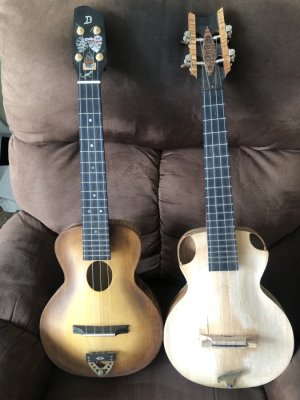Here's an example of taking frequency response measurements for individual strings for a popular commercial soprano with ply soundboard (high G - orange, C- green, E-blue, and A - brown). The difference in peak heights for the fundamental tones (4 highest peaks on the left side) are probably mostly the difference in how hard I plucked the strings, so that's not significant. I was looking for the difference in height between the fundamental peak and subsequent harmonic peaks for each string, and also what multiples the harmonics were from the fundamental.
This was a very rough and ready test setup. I laid the ukuleles down on my couch with a pillow under the neck. I have a calibrated measurement mic that I set up on a boom mic stand pointing at the sound hole (perpendicular to the sound board, probably a couple inches away), ran the signal through a mixer and into my laptop sound card. I plucked each string individually and took a snapshot of frequency response using the RTA function of the REW software.
Something glitchy happened where the fundamental peaks for C, E, and A occurred a bit off from where they should have in Hz, while the high G was pretty close at 389 Hz. So this should be taken with a grain of salt. If I was doing this seriously, I would try to figure out what happened there. I'm pretty sure I tuned carefully before doing this, although it was a few years ago.
View attachment 162650
I also did a similar set of measurements for a commercial concert scale uke with what appears to be a solid western red cedar top. In this case, the 2nd peaks were not as attenuated as the fundamental peaks, and some of the third peaks were almost as strong as the fundamentals. Same caveat applies about the C, E, and A fundamental peaks not landing in the right spots.
View attachment 162655



